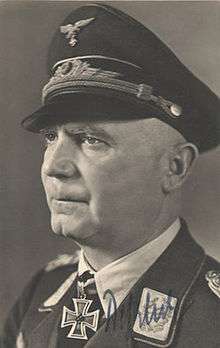Otto Deßloch
| Otto Dessloch | |
|---|---|
 Otto Dessloch | |
| Born | 11 June 1889 |
| Died | 13 May 1977 (aged 87) |
| Allegiance |
|
| Service/branch |
Heer Luftwaffe |
| Years of service | 1910–45 |
| Rank | Generaloberst |
| Battles/wars |
World War II |
| Awards | Knight's Cross of the Iron Cross with Oak Leaves |
Otto Dessloch (11 June 1889 – 13 May 1977) was a German Luftwaffe general during World War II and recipient of the Knight's Cross of the Iron Cross with Oak Leaves of Nazi Germany.
Career
Dessloch joined the Bavarian Army in 1912 and served during World War I. After the German defeat, he joined the right-wing Freikorps forces of Franz von Epp, fighting against the Bavarian Soviet Republic. From 1921, he served as an intelligence officer in the German Reichswehr. In the course of German re-armament, he attended the secret Lipetsk fighter-pilot school in 1926–27. Dessloch took part in the fast build-up of the Luftwaffe after the Nazi seizure of power in 1933, from 1 December 1934 as commander of a Deutsche Verkehrsfliegerschule (flight training school). From 1935 he served as commander of two Luftwaffe wings.
During World War II he commanded a Luftflotte 2 corps from 3 October 1939 and was appointed Major general and commander of the 6th flight division on December 1. He provided air support to the Wehrmacht Army Group B in the 1940 Battle of France and from 1941 commanded Luftwaffe units on the Eastern Front. Promoted to General der Flieger on 1 January 1942, he served as a commander on the southern Eastern Front and in the Caucasus Mountains. On 11 June 1943 Dessloch succeeded Wolfram Freiherr von Richthofen as commander-in-chief of Luftflotte 4 in the rank of Colonel general.
When in summer 1944 the Western Front collapsed, Dessloch was appointed commander of Luftflotte 3 by Hermann Göring to replace dismissed Hugo Sperrle. After Paris was liberated by the Allied forces, Dessloch commanded an air unit that, in retaliation, bombed the city destroying civilian targets and killing 200 French civilians on September 1944.[1] The attack was carried out on Hitler's personal order. From September he again served as commander of Luftflotte 4 until he succeeded Robert Ritter von Greim as head of Luftflotte 6 during the last days of the war. Dessloch was interned by the Allies until 1948.
According to the Yad Vashem Memorial in Israel, Otto Dessloch is a war criminal.[2] He died in Munich in 1977.
Awards
- Iron Cross (1914) 2nd Class (20 August 1914) & 1st Class (21 September 1915)[3]
- Bavarian Military Merit Order 4th Class with Swords (19 April 1915) & 4th Class with Crown and Swords (9 November 1917)[3]
- Wound Badge (1914) in Black (15 May 1918)[3]
- Clasp to the Iron Cross (1939) 2nd Class (13 May 1940) & 1st Class (24 May 1940)[3]
- Knight's Cross of the Iron Cross with Oak Leaves
- Knight's Cross on 24 June 1940 as Generalmajor and commanding general of the II. Flak-Korps[4]
- 470th Oak Leaves on 10 May 1944 as Generaloberst and commander in chief of Luftflotte 4[5]
- Mentioned in the Wehrmachtbericht on 4 August 1943, 9 April 1944, 30 October 1944 and 29 November 1944
References
Citations
Bibliography
- Fellgiebel, Walther-Peer (2000) [1986]. Die Träger des Ritterkreuzes des Eisernen Kreuzes 1939–1945 — Die Inhaber der höchsten Auszeichnung des Zweiten Weltkrieges aller Wehrmachtteile [The Bearers of the Knight's Cross of the Iron Cross 1939–1945 — The Owners of the Highest Award of the Second World War of all Wehrmacht Branches] (in German). Friedberg, Germany: Podzun-Pallas. ISBN 978-3-7909-0284-6.
- Mitcham, Samuel W. Jr. (2007). Retreat to the Reich. Stackpole Books. ISBN 978-0-8117-3384-7.
- Scherzer, Veit (2007). Die Ritterkreuzträger 1939–1945 Die Inhaber des Ritterkreuzes des Eisernen Kreuzes 1939 von Heer, Luftwaffe, Kriegsmarine, Waffen-SS, Volkssturm sowie mit Deutschland verbündeter Streitkräfte nach den Unterlagen des Bundesarchives [The Knight's Cross Bearers 1939–1945 The Holders of the Knight's Cross of the Iron Cross 1939 by Army, Air Force, Navy, Waffen-SS, Volkssturm and Allied Forces with Germany According to the Documents of the Federal Archives] (in German). Jena, Germany: Scherzers Militaer-Verlag. ISBN 978-3-938845-17-2.
- Thomas, Franz; Wegmann, Günter (1991). Die Ritterkreuzträger der Deutschen Wehrmacht 1939–1945 Teil V: Die Flugabwehrtruppen 1: A–K [The Knight's Cross Bearers of the German Wehrmacht 1939–1945 Part V: The Air Defense Troops 1: A–K] (in German). Osnabrück, Germany: Biblio-Verlag. ISBN 978-3-7648-1153-2.
- Die Wehrmachtberichte 1939–1945 Band 2, 1. Januar 1942 bis 31. Dezember 1943 [The Wehrmacht Reports 1939–1945 Volume 2, 1 January 1942 to 31 December 1943] (in German). München, Germany: Deutscher Taschenbuch Verlag GmbH & Co. KG. 1985. ISBN 978-3-423-05944-2.
- Die Wehrmachtberichte 1939–1945 Band 3, 1. Januar 1944 bis 9. Mai 1945 [The Wehrmacht Reports 1939–1945 Volume 3, 1 January 1944 to 9 May 1945] (in German). München, Germany: Deutscher Taschenbuch Verlag GmbH & Co. KG. 1985. ISBN 978-3-423-05944-2.
| Military offices | ||
|---|---|---|
| Preceded by none |
Commander of Kampfgeschwader 155 1 April 1936 – 1 February 1938 |
Succeeded by Generalmajor Wilhelm Süssmann |
| Preceded by none |
Commander of II. Flakkorps 30 October 1939 – 31 March 1942 |
Succeeded by General der Flakartillerie Job Odebrecht |
| Preceded by Generalfeldmarschall Wolfram Freiherr von Richthofen |
Commander of Luftflotte 4 4 September 1943 – 17 February 1944 |
Succeeded by Generalleutnant Alexander Holle |
| Preceded by Generalleutnant Alexander Holle |
Commander of Luftflotte 4 28 September 1944 – 21 April 1945 |
Succeeded by redesignated to Luftwaffenkommando 4 |
| Preceded by Generalfeldmarschall Robert Ritter von Greim |
Commander of Luftflotte 6 27 April 1945 – 8 May 1945 |
Succeeded by disbanded |
